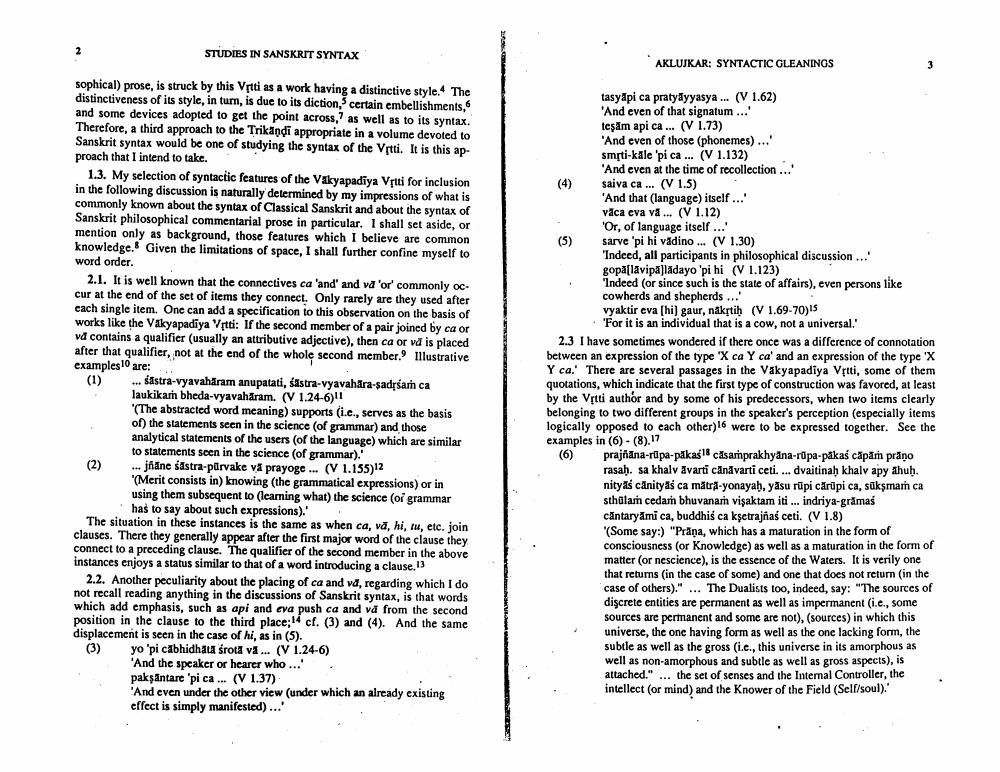Book Title: Syntactic Gleanings From Bhartharis Trikandi Author(s): Ashok Aklujkar Publisher: Ashok Aklujkar View full book textPage 2
________________ STUDIES IN SANSKRIT SYNTAX sophical) prose, is struck by this Vṛtti as a work having a distinctive style. The distinctiveness of its style, in turn, is due to its diction, certain embellishments, and some devices adopted to get the point across, as well as to its syntax. Therefore, a third approach to the Trikandi appropriate in a volume devoted to Sanskrit syntax would be one of studying the syntax of the Vitti. It is this approach that I intend to take. 1.3. My selection of syntactic features of the Vakyapadiya Vitti for inclusion in the following discussion is naturally determined by my impressions of what is commonly known about the syntax of Classical Sanskrit and about the syntax of Sanskrit philosophical commentarial prose in particular. I shall set aside, or mention only as background, those features which I believe are common knowledge. Given the limitations of space, I shall further confine myself to word order. 2.1. It is well known that the connectives ca 'and' and va 'or' commonly occur at the end of the set of items they connect. Only rarely are they used after each single item. One can add a specification to this observation on the basis of works like the Vakyapadiya Vitti: If the second member of a pair joined by ca or vd contains a qualifier (usually an attributive adjective), then ca or va is placed after that qualifier, not at the end of the whole second member. Illustrative examples 10 are: (1) ... sastra-vyavahāram anupatati, sastra-vyavahara-sadṛśam ca laukikam bheda-vyavaharam. (V 1.24-6)11 "(The abstracted word meaning) supports (i.e., serves as the basis of) the statements seen in the science (of grammar) and those analytical statements of the users (of the language) which are similar to statements seen in the science (of grammar)." ... jñāne sastra-pürvake va prayoge... (V 1.155)12 (2) (Merit consists in) knowing (the grammatical expressions) or in using them subsequent to (learning what) the science (or grammar has to say about such expressions)." The situation in these instances is the same as when ca, va, hi, tu, etc. join clauses. There they generally appear after the first major word of the clause they connect to a preceding clause. The qualifier of the second member in the above instances enjoys a status similar to that of a word introducing a clause,13 2.2. Another peculiarity about the placing of ca and va, regarding which I do not recall reading anything in the discussions of Sanskrit syntax, is that words which add emphasis, such as api and eva push ca and va from the second position in the clause to the third place; 14 cf. (3) and (4). And the same displacement is seen in the case of hi, as in (5). (3) yo 'pi cabhidhata śrota va... (V 1.24-6) 'And the speaker or hearer who...' pakṣantare 'pi ca... (V 1.37) 'And even under the other view (under which an already existing effect is simply manifested)..." (4) (5) AKLUJKAR: SYNTACTIC GLEANINGS tasyapi ca pratyayyasya... (V 1.62) 'And even of that signatum...' teşăm api ca... (V 1.73) 'And even of those (phonemes)...' smrti-käle 'pi ca... (V 1.132) 'And even at the time of recollection...' saiva ca... (V 1.5) 'And that (language) itself..." vaca eva va... (V 1.12) 'Or, of language itself...' sarve 'pi hi vadino... (V 1.30). 'Indeed, all participants in philosophical discussion...' gopallavipā]ladayo 'pi hi (V 1.123) Indeed (or since such is the state of affairs), even persons like cowherds and shepherds..." vyaktir eva [hi] gaur, näkṛtiḥ (V 1.69-70)15 For it is an individual that is a cow, not a universal.' 3 2.3 I have sometimes wondered if there once was a difference of connotation between an expression of the type 'X ca Y ca' and an expression of the type 'X Y ca. There are several passages in the Vakyapadiya Vṛtti, some of them quotations, which indicate that the first type of construction was favored, at least by the Vitti author and by some of his predecessors, when two items clearly belonging to two different groups in the speaker's perception (especially items logically opposed to each other) 16 were to be expressed together. See the examples in (6) (8).17 (6) prajñāna-rūpa-pākas 18 casamprakhyana-rupa-pakaś cāpām prāṇo rasaḥ, sa khalv avarti canavarti ceti. ... dvaitinaḥ khalv apy ahuḥ. nityaś canityaś ca mătră-yonayaḥ, yāsu rūpi cărūpi ca, sūksmaṁ ca sthülam cedam bhuvanam vişaktam iti... indriya-grāmaś căntaryāmi ca, buddhiś ca kşetrajñaś ceti. (V 1.8) (Some say:) "Prana, which has a maturation in the form of consciousness (or Knowledge) as well as a maturation in the form of matter (or nescience), is the essence of the Waters. It is verily one that returns (in the case of some) and one that does not return (in the case of others)."... The Dualists too, indeed, say: "The sources of discrete entities are permanent as well as impermanent (i.e., some sources are permanent and some are not), (sources) in which this universe, the one having form as well as the one lacking form, the subtle as well as the gross (i.e., this universe in its amorphous as well as non-amorphous and subtle as well as gross aspects), is attached."... the set of senses and the Internal Controller, the intellect (or mind) and the Knower of the Field (Self/soul)."Page Navigation
1 2 3 4 5 6
